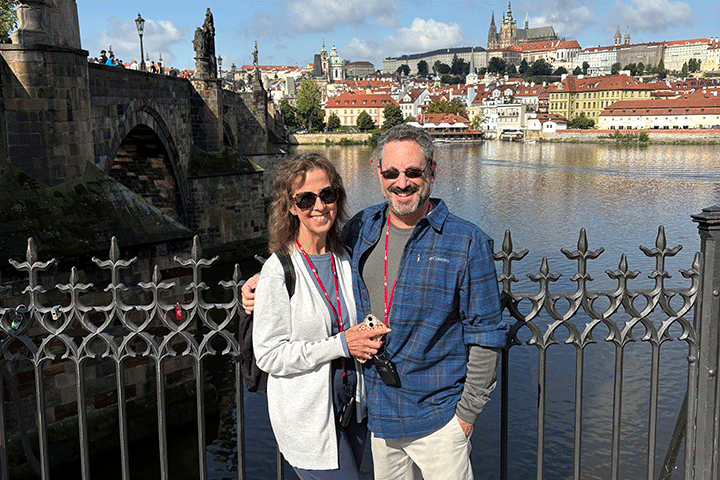A Long Journey That Began With Pancreatitis

- Pancreatitis leads to diagnosis of acinar cell carcinoma
- Distal pancreatectomy and splenectomy
- Recurrences lead to chemotherapy, targeted therapy, and two types of radiation treatments
It all started with one bout of pancreatitis in June 2017.
The pancreatitis kept coming back again and again. My doctors said that each recurrence of pancreatitis increased my chances of developing pancreatic cancer. So we kept a close eye on my pancreas with regular CT scans. This went on for more than a year.
In October 2018, a scan revealed something troublesome on my pancreas. My gastroenterologist ordered an ERCP and took a biopsy. After conflicting reports were analyzed more closely, it was concluded that I had stage II acinar cell carcinoma (ACC), a rare form of pancreatic cancer.
It was a catch-22 situation—the pancreatitis attacks led to me developing cancer, but because of these attacks we were keeping a close eye on the area, and therefore we were able to catch it early.
Surgery First
In December 2018, Dr. Ganesh Gunasekaran performed my distal pancreatectomy and splenectomy at Mount Sinai in New York City. During this procedure, Dr. Gunasekaran removed the tumor that was located in the tail of my pancreas. We opted to forego post-surgery treatments because the margins of my tumor removal were so clear. Also, all of the 22 lymph nodes that were tested during the surgery came back negative, and there was little documentation showing that I would benefit from chemo.
I did not want to put my body through hell if it was not absolutely necessary.
My Life Changed Forever
Three months after the surgery (March 2019), I had a follow-up CT scan and it showed no evidence of disease in my body. I thought I was on a good path. But another scan three months later showed that about 25 tumors appeared out of nowhere and had metastasized in my liver. Stage IV. This was, of course, a shock. My life was turned upside down and changed forever in a matter of minutes.
My surgeon recommended Dr. Richard Lee, an oncologist in Merrick, not that far from my condo in the beachfront town of Long Beach, on Long Island. I went to see him the next day. He said I needed to start chemotherapy right away and that I should get the strongest option available: FOLFIRINOX. Within two days I had a port implanted and I was ready for my first infusions.
Insisting on Another Biopsy
Before starting the treatment, however, I wanted to be absolutely confident that we were dealing with the same type of acinar cell cancer that I had been diagnosed with previously. A different type of cancer might require a different treatment. So I insisted on getting a biopsy of the new tumors. The results came back while I was in the chair and being prepped for my first infusion. Yes, it was still acinar cell carcinoma.
I went ahead with the infusion of FOLFIRINOX and received a fluorouracil (5-FU) pack to take home as a parting gift. Two days after completing the treatment at home, I decided to discontinue the chemo entirely. It’s not that the side effects were so bad. I just wanted to try something outside of the box and avoid using such a strong chemo. I also met Dr. Allyson Ocean at Weill Cornell Medicine (New York) to discuss treatment options at this time. I decided to explore an alternative treatment for four months, which ultimately proved ineffective, so I moved back to the standard of care.
Perfect Timing
During this time, I underwent genetic testing and found out that I carry the BRCA2 mutation. The BRCA2 mutation enabled me to be a candidate for Lynparza. Talk about perfect timing. On December 27, 2019, one day before my 70th birthday, I received the best present I could have asked for: the FDA approved the PARP inhibitor Lynparza for the treatment of pancreatic cancer. I started receiving the treatment in my home two weeks later.
Over the course of eighteen months on this treatment, my tumors shrank and eventually vanished. Unlike one particularly memorable episode of Seinfeld, “shrinkage” is a great thing for cancer patients! It is the word we all hope to hear.
While on Lynparza I started to develop anemia. I stopped taking the drug for about three weeks and then resumed on a lower dosage, which eliminated the problem. This continued for about a year and a half and I felt like I was in a good place. But there is more to my story.
Y90 Liver Therapy
Several tumors started to grow in my liver again. This time, Dr. Ocean and I chose a type of radiation treatment called yttrium-90 (or Y90). This procedure was done by Dr. Steve Lee at Weill Cornell. It worked for me and there were few side effects, although I may have lit up a room when I entered. I had to have the treatment a second time when new tumors appeared in my liver a few months later, and it was successful. But that still isn’t the end of the story….
I had about ten months of bliss where there was no active disease in my body. In spring 2022 a scan revealed two tumors on my peritoneum, the lining around my abdominal organs. One of my goals since the start of my journey was to avoid the stronger chemo treatments and their side effects. At my request, Dr. Ocean agreed that I could have metronomic chemo this time around, which is a lower dosage that is given more often. I did this for three months and, unfortunately, it proved to be ineffective—the tumors grew larger and more tumors appeared.
We decided to try stereotactic body radiation therapy (SBRT) instead. For this treatment I was working with radiation oncologist Dr. John Ng, of Weill Cornell Medicine. I also began taking Keytruda. I started the treatment with one Keytruda infusion two weeks before the SBRT, another during the five days of SBRT, and then a continuation of Keytruda until the end of January.
SBRT and Keytruda Worked!
The three tumors shrank and eventually one of them disappeared. Overall, the SBRT and Keytruda combination was a success! There were no side effects from the SBRT but I did have some from the Keytruda, like hypothyroidism, which is under control with levothyroxine. Of course, there’s still more to the story.
In April 2023 I noticed a bump on my chest. A previous scan had shown something new, which the doctors thought to be a remnant from the SBRT or a bit of scar tissue. The lump was about one centimeter wide, so we left it alone. It turned out to be another acinar cell tumor on my right rectus muscle and it was growing larger week by week. Pretty soon I could have hung a towel from it! I got mapped out for SBRT again but decided to have the tumor surgically removed instead. Dr. Michael Kluger at Columbia University Irving Medical Center (New York) removed the tumor on June 30, 2023. There were no complications and the margins were clear.
It’s Been a Long Journey
In September, scans showed that I developed five tumors once again in my liver, and one tumor on my omentum. I just can’t seem to catch a break with the reoccurrences! Back to Dr. Steve Lee for a Y90 procedure on the liver, and a visit to Dr. Ng for SBRT treatments for the tumor on the omentum. My latest scans in December showed all of these tumors are now dead. Yippee! However, and I hate to see that word on a report, I have one new tumor in my liver about 2 cm and one very small new tumor, about 7 mm, on my peritoneum. I will be going to see Dr. Ng on December 28th, my 74th birthday, to get mapped out for the SBRT treatments we will do on both tumors. I have no doubt that these tumors will head down the same road to oblivion like those that were zapped the same way before them!
I have managed to avoid the stronger chemo treatments to this point, which has been a goal of mine all along. In doing so I have been able to dodge the more impactful side effects on my quality of life, such as neuropathy, sensitivity to cold, nausea, extreme tiredness. I have been able to do much of what I could do before my diagnosis, and for that, I am very grateful.
After this very long journey, I am proud to be a person who is living with pancreatic cancer.
Watch Paul tell his story in “Proud to be Living with Pancreatic Cancer.”







